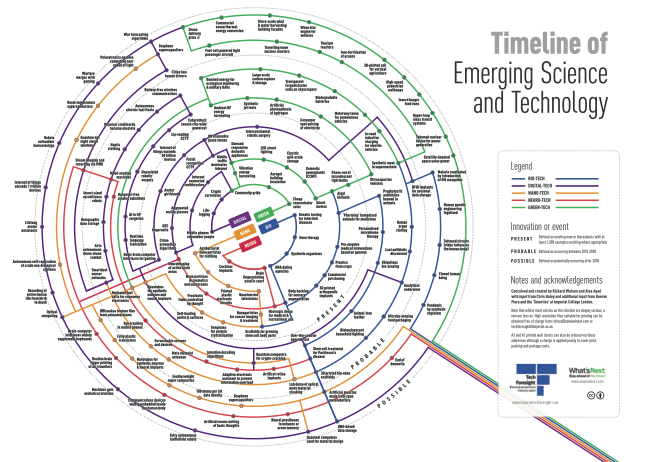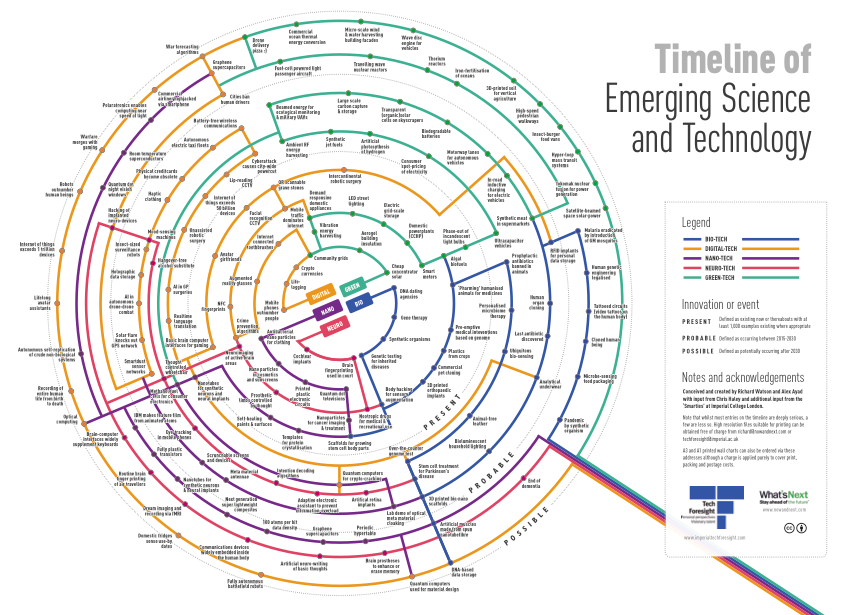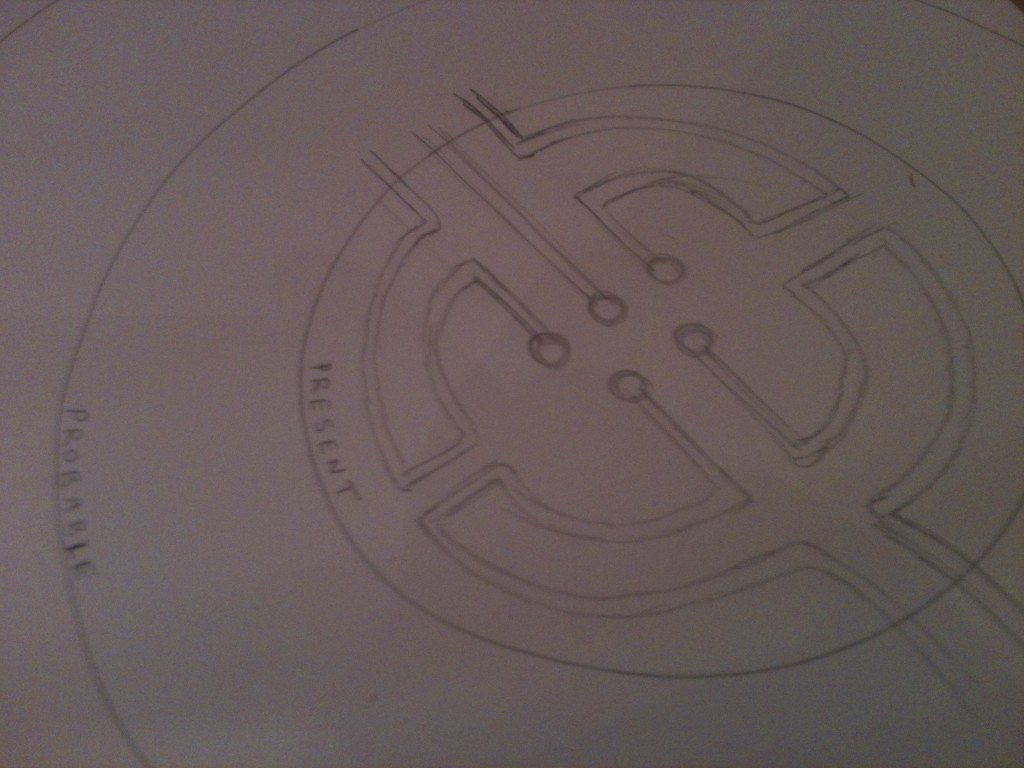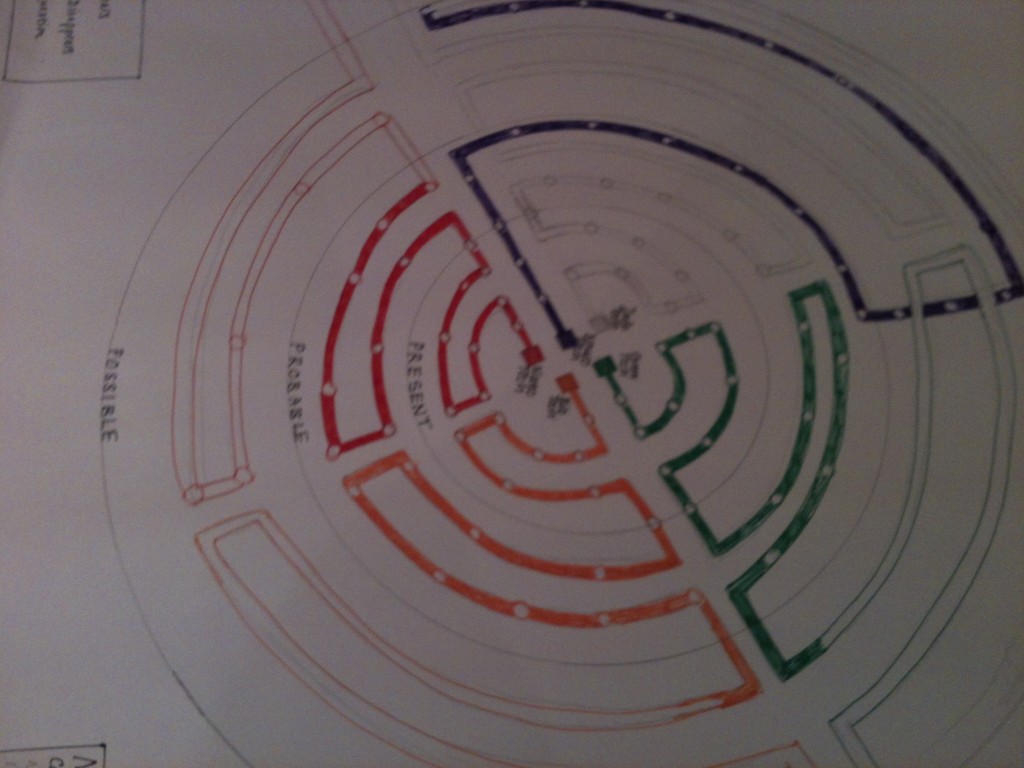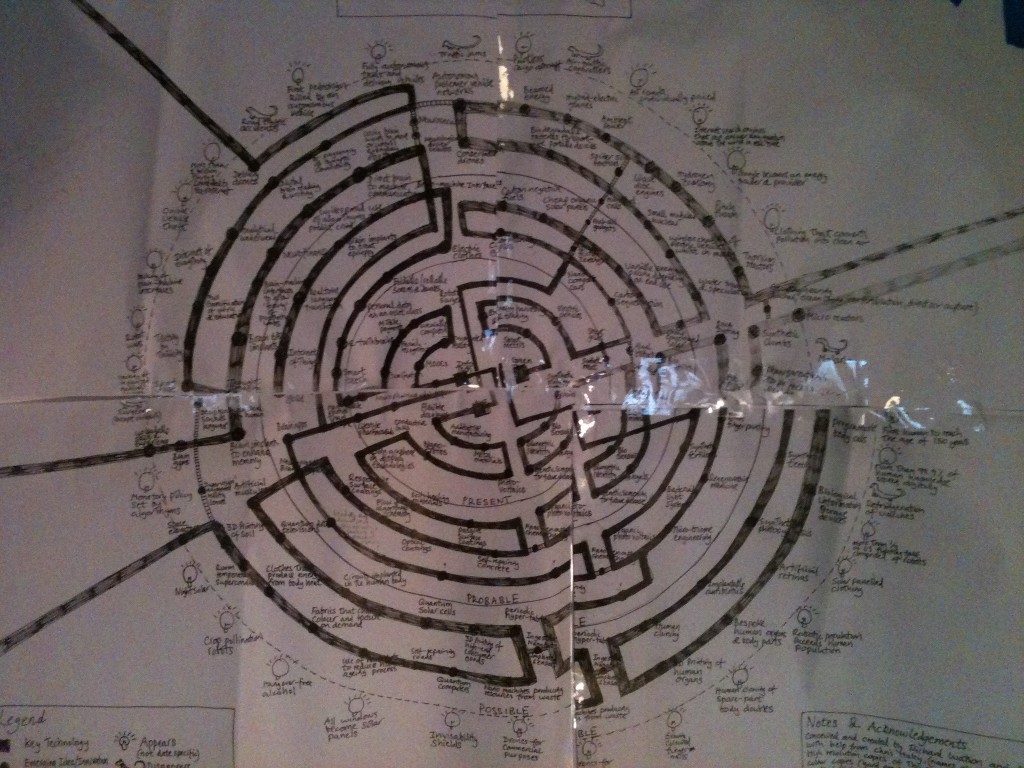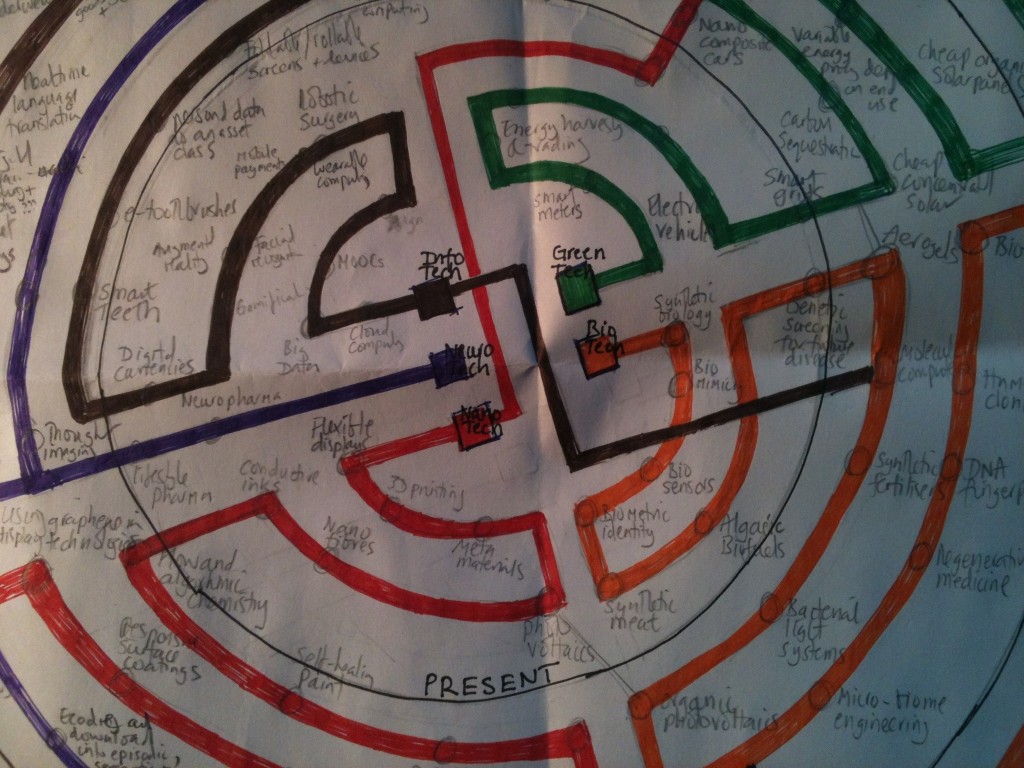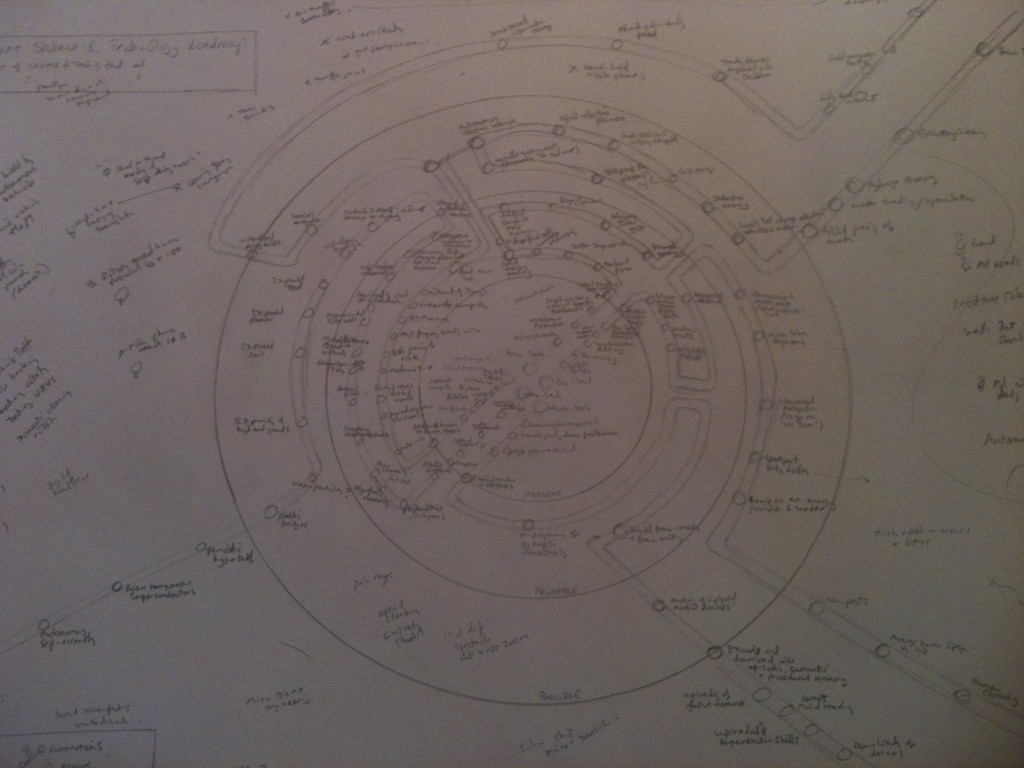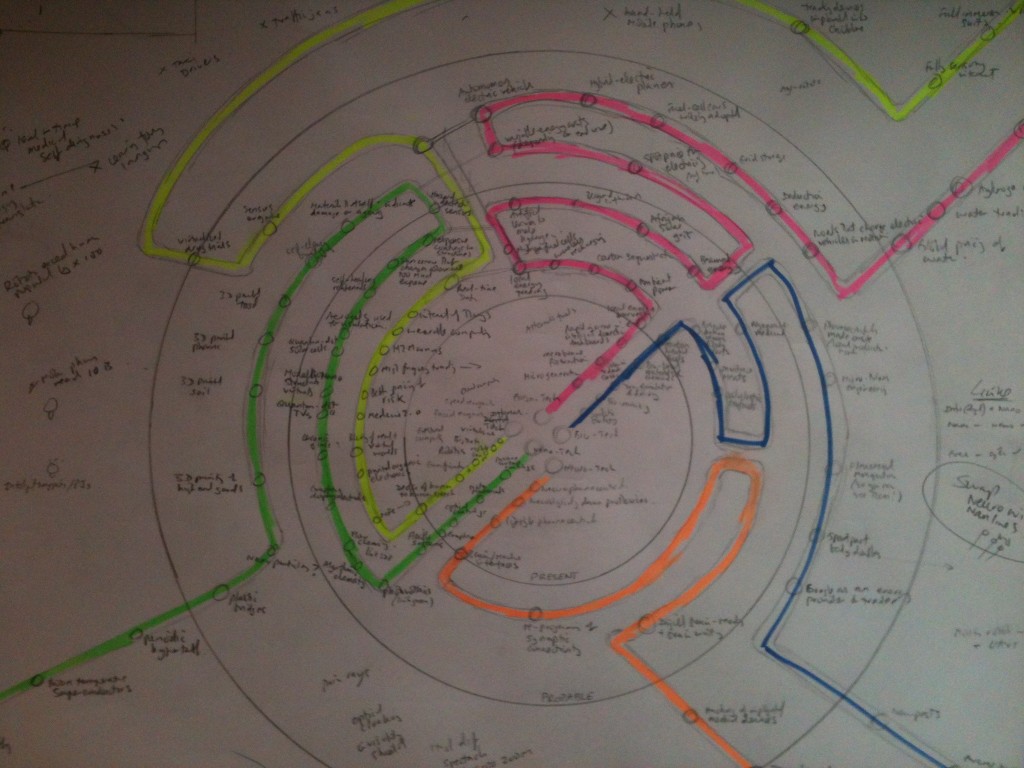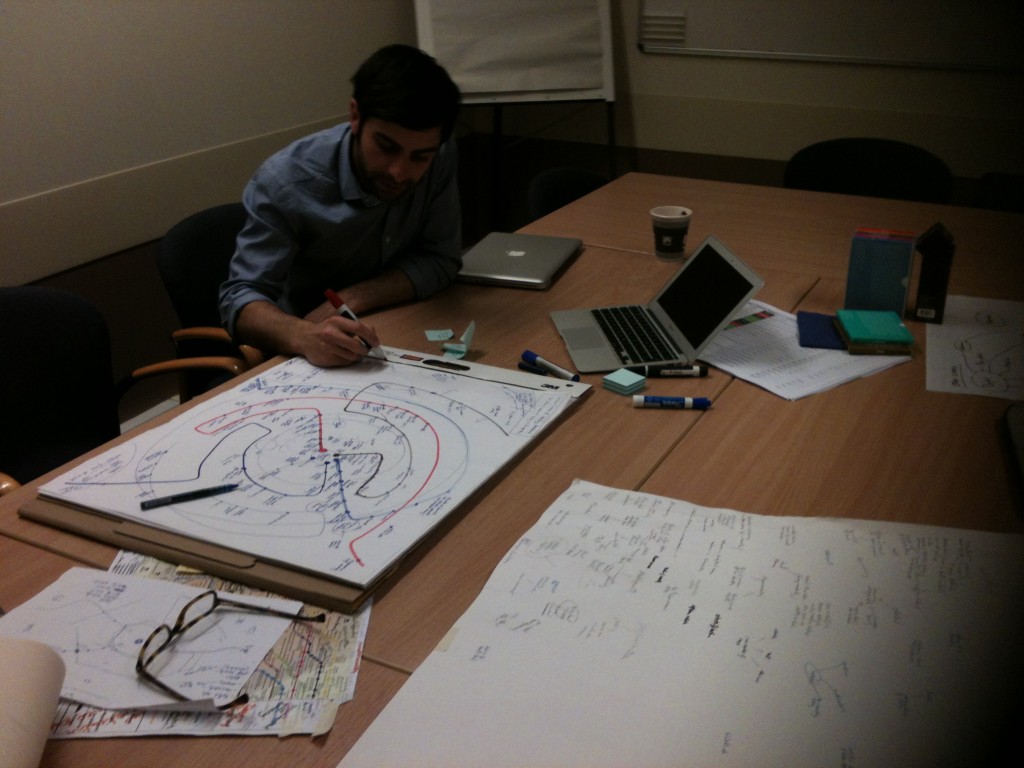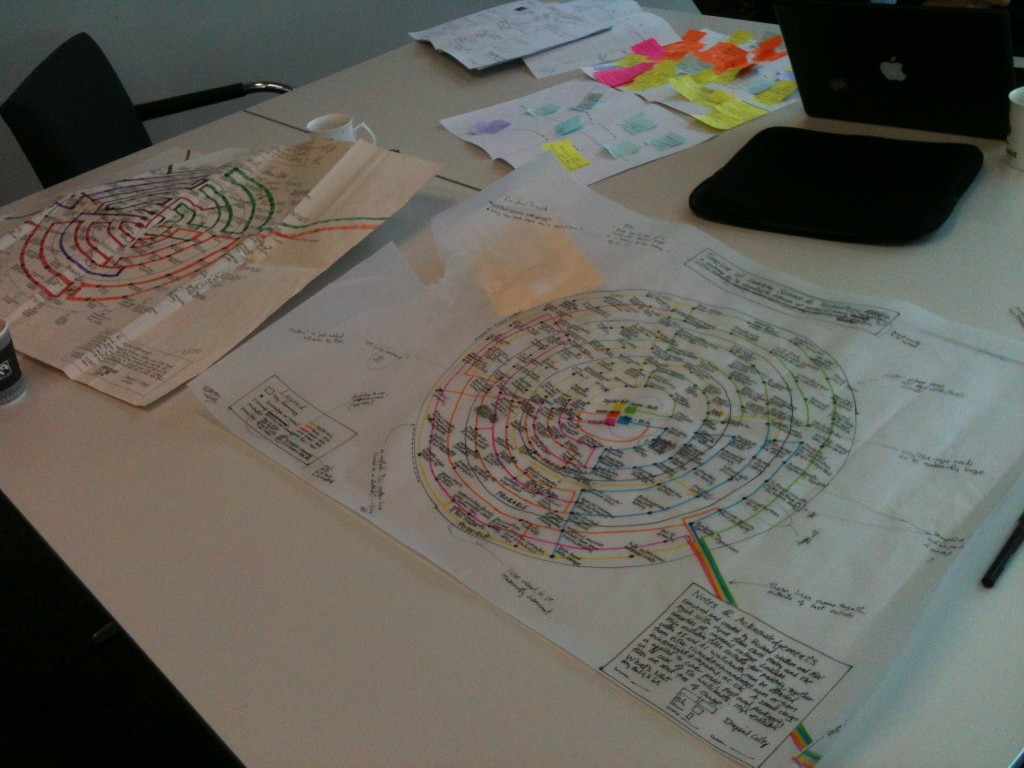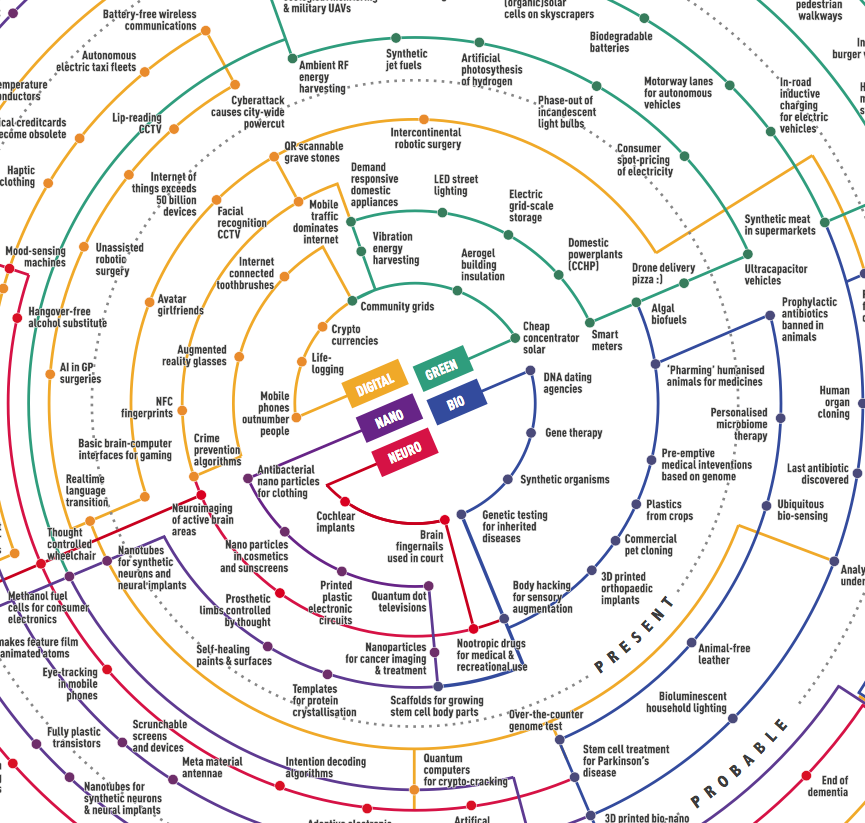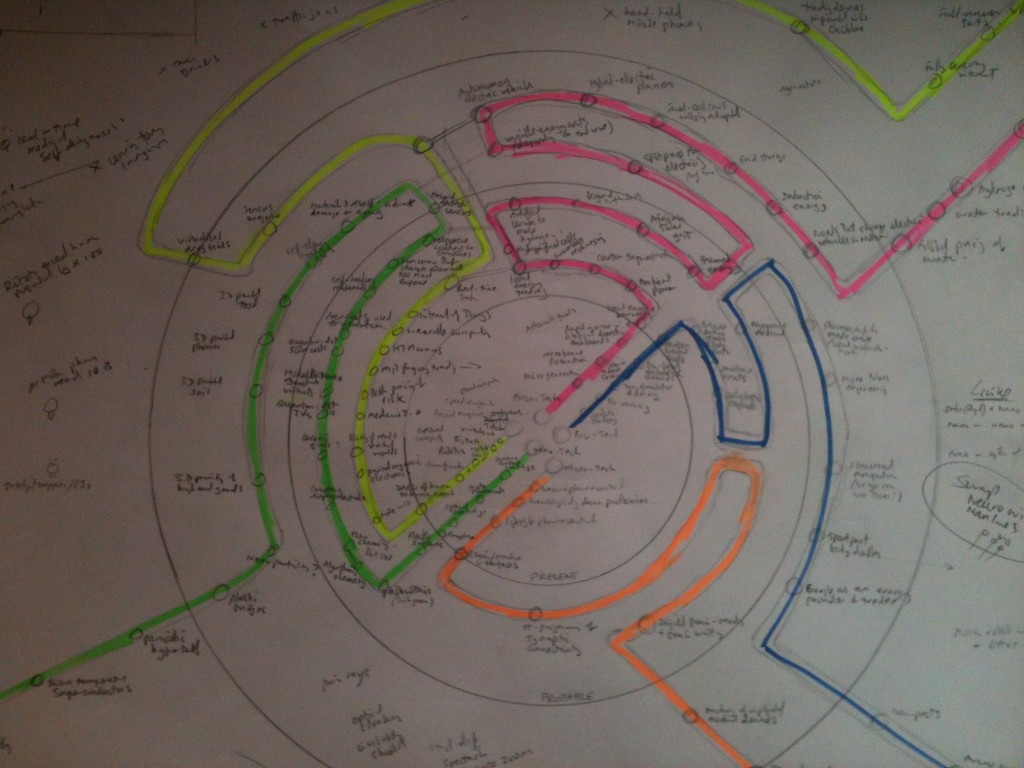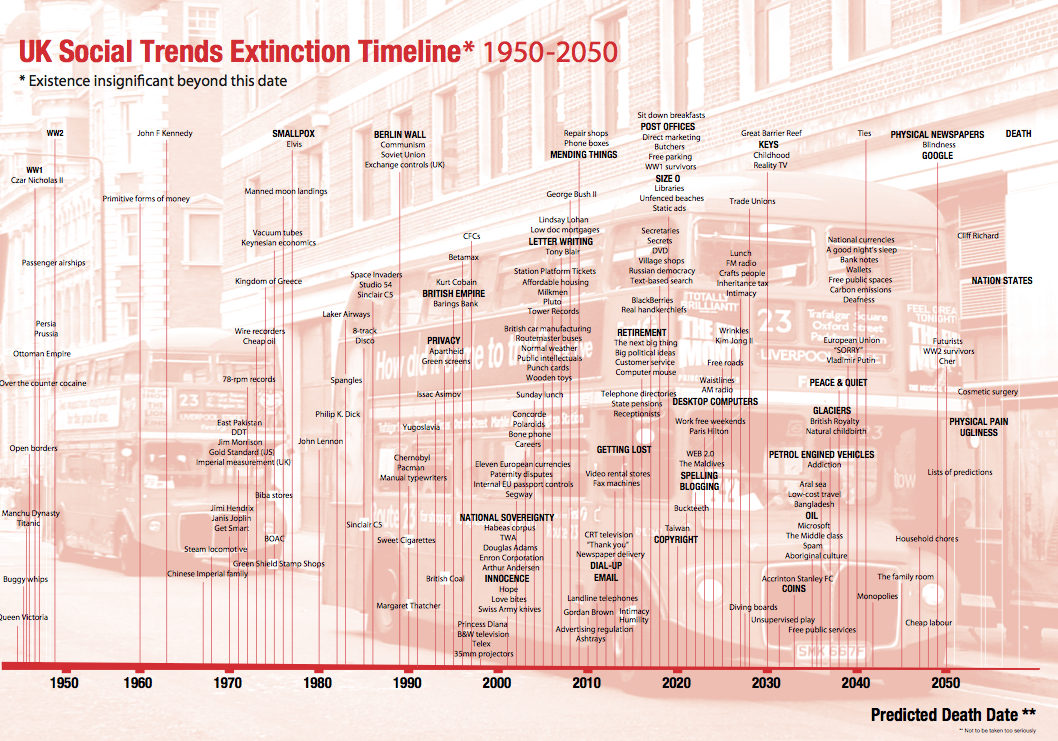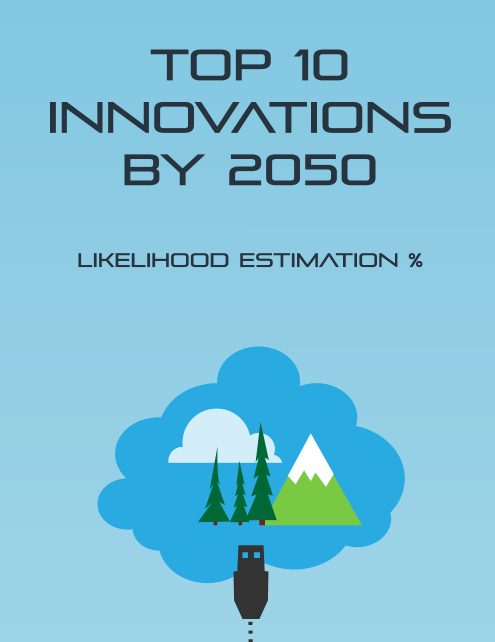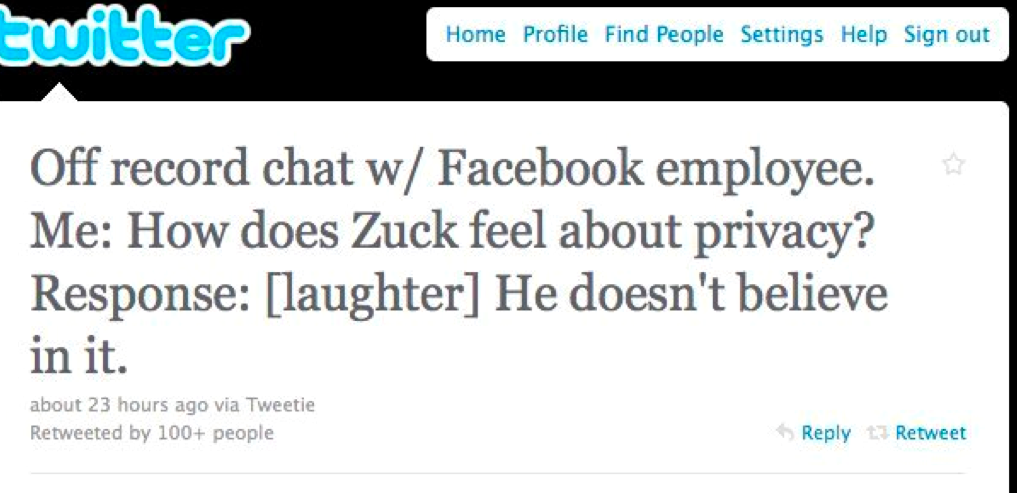If you want to print, this is the file to use. Also very final version. We are printing one 3m x 2m for an emerging tech conference at Imperial so good for larger sizes. PDF download here (3.8 meg) EmergingScienceTech-FINAL
Category Archives: Predictions
Timeline of Emerging Science & Technology (2014 to 2030+)
Here is the timeline of emerging science & technology created in conjunction with the technology-forecasting folks at Imperial College London (especially Alex Ayad, but a big thanks to Chris Haley in the later stages too). Above is an image of the finished map. We had a long discussion about whether to have ‘Mobile phones outnumber people’ as ‘Present’, but at 6.9 billion phone subscriptions it’s close enough.
Download a high resolution PDF suitable for printing (Colour A3, or larger, recommended).
If you’d like a printed paper hard copy these will be available in a week or so.
At the bottom of this post are a few images showing how the map was created and how the image evolved.
In terms of what’s on the map, there are 5 key mega-technologies, which are Digital-tech (Essentially Info-tech), Bio-tech, Nano-tech, Neuro-tech and Green-tech (sometimes referred to as clean-tech).
We have split the map into 3 time zones. The first is ‘Present’, which we are defining as now or thereabouts (2014-2015) with at least 1,000 working examples where appropriate (events can be one-off occurrences, but innovations generally need at least 1,000 working examples to be included). ‘Probable’ is the second zone and this is defined as 2015-2030. The third zone is ‘Possible’, defined as being potentially available from 2030 onwards. Most of the map is serious, but we couldn’t resist having some fun in a few areas 🙂
Hope you all enjoy it and do please pass it along if you find it interesting or useful. Note that the timeline is published under a Creative Commons license so you can use it commercially or make versions of it without asking, although we would be grateful if anyone using it links back to our original version.
As for what’s on each line here’s a list.
Green-tech present
Cheap concentrator solar
Aerogel building insulation
Vibration energy harvesting
Community grids
Demand responsive domestic appliances
LED street lighting
Electric grid-scale storage
Domestic power plants (CCHP)
Smart meters
Algal biofuels
Green-tech probable
Ultra capacitor vehicles
Consumer spot-pricing of electricity
100% phase out of incandescent light bulbs
Artificial photosynthesis of hydrogen
Synthetic jet fuels
Ambient RF energy harvesting
Beamed energy for ecological monitoring & military UAVs
Large scale carbon capture & storage
Transparent (organic) solar cells on skyscrapers
Biodegradable batteries
Motorway lanes for autonomous vehicles
In-road inductive charging for electric vehicles
Synthetic meat in supermarkets
Green-tech possible
Travelling wave nuclear reactors
Fuel cell powered light passenger aircraft
Drone delivery of pizza
Commercial ocean thermal energy conversion
Micro-scale wind and water harvesting building facades
Wave disc engines for vehicles
Thorium reactors
Iron fertilisation of oceans
3D printed soil for vertical agriculture
High-speed pedestrian walkways
Insect-burger food vans
Hyper-loop mass transit systems
Tokomak nuclear fusion for power generation
Satellite beamed space-solar power
Bio-tech present
DNA dating agencies
Gene therapy
Synthetic organisms
Genetic testing for inherited diseases
Body hacking for sensory augmentation
3D printed orthopaedic implants
Commercial pet cloning
Plastics from crops
Pre-emptive medical interventions based on genome
‘Pharming’ humanised animals for medicines
Bio-tech probable
Prophylactic antibiotics banned in animals
Personalised micro biome therapy
Ubiquitous bio sensing
Animal-free leather
Over the counter genome test
Stem-cell treatment for Parkinson’s disease
3D printed bio-nano scaffolds
Human organ cloning
RFID implants for personal data storage
Last antibiotic discovered
Bio-tech possible
Artificial muscles from spun Nano-fibre
DNA based data storage
Microbe-sensing food packaging
Malaria eradicated via introduction of GM mosquitos
Human genetic engineering legalised
Tattooed circuits (video tattoos on the human body)
Cloned human being
Pandemic by synthetic organism
Digital-tech present
Mobile phones outnumber people (shift end of present?)
Life-logging
Crypto currencies
Internet connected toothbrushes
Augmented reality glasses
Crime prevention algorithms
NFC fingernails
QR scanable gravestones
Facial recognition CCTV
Avatar girlfriends
Basic brain-computer interfaces for gaming
Intercontinental robotic surgery
Digital-tech probable
Real-time language translation
Quantum computers for crypto cracking
Analytical underwear
AI in GP surgeries
Unassisted robotic surgery
Internet of things exceeds 50 billion devices
Lip-reading CCTV
Cyber attack causes citywide power cut
Battery-free wireless communications
Autonomous electric taxi fleets
Physical credit cards become obsolete
Haptic clothing
Mood sensing moods
Insect-sized surveillance robots
Holographic data storage
AI in autonomous drone-drone combat
Solar flair knocks out GPS network
Digital-tech possible
Hacking of implanted neuro-devices
Cities ban human drivers
War forecasting algorithms
Commercial aircraft highjacked via smart phone
Warfare merges with gaming
Robots outnumber human beings
Internet of things exceeds 1 trillion devices
Lifelong avatar assistants
Recording of entire human life from birth to death
Domestic fridges sense use-by dates
Fully autonomous battlefield robots
Quantum computers used for material design
Nano-tech present
Antibacterial nano-particles for clothing
Nano-particles in cosmetics and sunscreens
Plastic printed electronic circuits
Quantum dot televisions
Nanoparticles for cancer imaging and treatment
Scaffolds for growing stem cell body parts
Templates for protein crystallisation
Self-healing paints and surfaces
Nanotubes for synthetic neurons and neural implants
Methanol fuels cells for consumer electronics
Nano-tech probable
Meta-material antennae
Scrunchable screens and devices
Nano-tech possible
Lab demo of optical meta material cloaking
Polartronics enables computing near speed of light
Room temperature superconductors
Quantum dot night vision windows
Autonomou data density
Graphene super capacitorss self-replication of crude non-biological systems
IBM makes feature film from animated atoms
Fully plastic transistors
Nanotubes for synthetic neurons and neural implants
Next generation super-light composites
100 atoms per bit data density
Neuro-tech present
Cochlear implants
Brain fingerprinting used in court
Nootropic drugs for medical and recreational use
Prosthetic limbs controlled by thought
Neuro imaging of active brain areas
Neuro-tech probable
Thought controlled wheelchair
Eye tracking in mobile phones
Intention decoding algorithms
Adaptive electronic assistant to prevent information overload
Artificial retina implants
Hangover-free alcohol substitute
Neuro-tech possible
Hacking of implanted neuro devices
Brain-computer interfaces widely supplement keyboards
Routine brain finger printing of air travellers
Dream imaging and recording via fMRI
Communications devices widely embedded inside the human body
Artificial neuro-writing of basic thoughts
Brain prostheses to enhance or erase memory
End of dementia
Design development
The design is loosely based upon my previous 2010+ trends and technology timeline. (Click here for PDF). The first rough was created with a pencil on an A3 sheet of white paper on the kitchen table and then progressed through numerous versions (about a dozen from memory). The circles were originally drawn using kitchen plates and large bowls and the coloured lines were originally created using a mixture of highlighter pens and my children’s marker pens. The final version – prior to professional design input -was drawn on A3 tracing paper so as to get things aligned and connecting. Design credit also belongs to Lawrence Whitely and a big thanks is also due to Kereen at Imperial College.
As for future updates we are already thinking about an animated version and perhaps positive and negative versions (utopian and dystopian versions). If you have any ideas about what should/shouldn’t be on future versions (or spot any silly mistakes do please tell us!!!).
Emerging tech map
Signs of the future
I try not to post more than once a day, but this is so good and related not only to my top extinctions list but also to the timeline of emerging technologies, which is coming out very soon. Click on this link for loads more images in a similar vein.
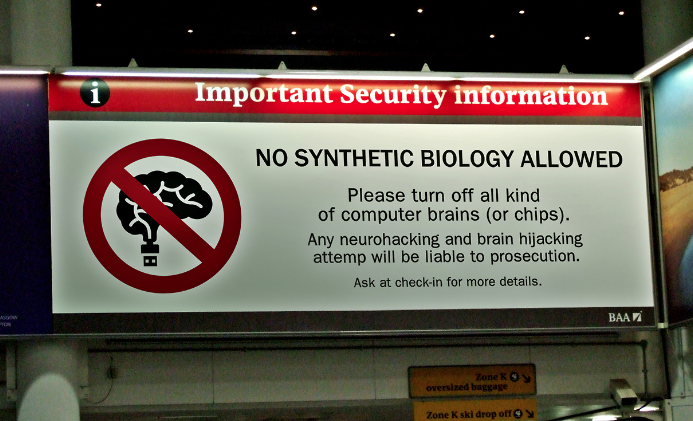
Person responsible is B.J. Murphy at the Institute for Ethics and Emerging Technologies and designer is Fernando Barbella. Thanks for Chris Haley at Nesta for passing it along. We are not worthy!
Things that might disappear by 2050
Some of you might remember the extinction timeline I designed with Ross Dawson a few years ago and perhaps even the update, which for some strange reason I did as an oil painting (it seemed like a really good idea at the time).
Anyway, here’s a further update featuring the possible extinction of privacy, handwriting, physical credit cards, video game consoles, the great barrier reef, malaria, commercial ocean fishing, surgeons, car accidents and perhaps even death by 2050. Thanks for Zeljko Zoricic for the visualisation.
Future Technologies
Future inventions
Russian expansionism
Just spotted this at the end of my book Future Files – 2012 update, page 302.
“Russia will become more nationalistic (and go outward militarily).”
This wasn’t my idea. It stems from reading The Next 100 Years by George Friedman. His chapter on Russia 2020 is worth a look. His general argument is that major conflicts tend to repeat themselves and therefore history can indeed be a good guide to the future.
” The Russians are extremely well aware that they are facing a massive demographic crisis. Russia’s current population is about 145 million, and projections for 2050 are for between 90 million and 125 million. Time is working against it. Russia’s problem will soon be its ability to field an army sufficient for its strategic needs. Internally, the number of Russians compared to other ethnic groups is declining, placing intense pressure on Russia to male a move sooner rather than later.”
I also liked his thought that you need to look at the psychology driving national politics. In the case of Russia (and France and the UK) it’s all about the loss of empire and a desire to regain influence. Anyone for the Rise of the Fifth Reich?
The Future of Privacy
We are currently living in the Technolithic, an age that forms part of the most significant revolution since the agricultural and industrial eras. The Technolithic is part of the information age, but what we are now creating is perhaps not what the early internet pioneers envisaged. In the early days, the internet was about finding information. It is currently largely about finding other people. One day, I hope, it will be about finding ourselves.
But before this can happen we have to deal with a very powerful force, a force that wants to know absolutely everything about us. This force can act for the common good, but can also operate to profit the few.
Who we are and what we are allowed to be, is at the very heart of this. Please don’t get me wrong. I am not calling on you to smash your computers or stop using LinkedIn. All I am asking you to do is to raise your gaze from your freshly picked Apples and Blackberries and to pay closer attention to some of the possible consequences of using these devices, especially the way in which machines and the people that control them appear to be profiting from something that not only belongs to us but defines us.
Digital connectivity has given us many wonderful things and improved our lives immeasurably. At the moment the balance is positive, but that doesn’t mean that we shouldn’t remain vigilant.
I was in Poland last year doing a TEDx talk and met one of the developers behind an app called Life Circle. This is an app that makes blood donation more effective by opening up the communication lines between blood banks and blood donors. This might sound mundane, but it isn’t. It’s a matter of life in death in some instances. Simply allowing a blood centre to have a users smartphone number means that they can see where their donors are in near real time.
This allows the blood bank to call in certain blood groups if there’s an emergency. It can work anywhere – from Warsaw to Washington – and users can link with social networks and potentially recruit more donors. Moreover, once linked you could potentially ‘game’ blood donation, although the idea of competing with others to see who can give the most blood would obviously be a very bad idea.
Another medical marvel is Google Flu Trends. If you don’t know about it already, it’s an early example of Big Data and near real-time prediction. The story is that some people had a feeling that there must be a correlation between outbreaks of flu in particular regions and search terms used in the same locations. If one could predict the right words you could catch an outbreak sooner.
200,000 people are hospitalised annually in the US alone due to flu and between 20,000 and 30,000 die, but until recently it took the Centre for Disease Control around a week to publish flu data.
The Big Data connection here, by the way, is that Google did not know which handful of search terms would correlate, so it just ran half a billion calculations to find out, and it turned out that 45 search terms were indeed related. What is going on here, and is starting to occur elsewhere too, is that rather than sampling small data sets we are able to look at huge amounts of data, sometimes at all the data in near-real-time, which can reveal correlations that were previously deeply hidden or totally unobservable.
In other words, many aspects of our daily existence that were previously closed, hidden or private are becoming much more open, transparent and public and much of this data has huge value and forms a wholly new asset class.
The website 23andme.com recently got into trouble in the US with the FDA because it was thought by some that the site, and the results of the tests that were being offered, was carrying too much weight and users were acting in ways that were not necessarily in their best interests. In other words, users were seeing probabilities or predictions as certainties.
Again, if you don’t know about this, the site essentially offers to quickly sequence your genome for around $99. A decade or so ago, this would have cost you around a billion dollars. The results might strongly suggest, for example, that a 25-year-old man would have issues with his heart when he was in his 50s or that a 15-year old girl had a significant chance of developing breast cancer.
There are clearly privacy issues galore around new technologies such as these – should your new employer have access to information that you are 70% certain to die in 20 years for example?
Another, more mundane, example of companies looking at people and predicting future outcomes is McDonald’s. They, along with many other fast food chains in the US, have started to use technology to predict what you are about to order – and start to prepare your meal before you have actually ordered anything.
How and why do they do this? In the US about 50% of fast food turnover is through the drive-thru window and customers can become stressed if the queue moves too slowly. CCTV cameras are therefore pointed at cars in the queue and these cameras are connected to software that works out what each car is, not based on individual number plates, but on the silhouette of each car.
This knowledge is then married to millions of bits of historical data about what the drivers of such cars tend to order and, hey presto, predictive sales and marketing. The general idea, I guess, is that if you are driving a 10-year-old Volvo station wagon you’ve probably got a mother and at least one happy meal coming up, whereas if you can see a brand new Hummer you are not about to sell a small salad and a bottle of water.
Is McDonald’s technology intrusive? Does it invade privacy? I don’t think so. If they are stealing anything it isn’t anything of great value. Moreover, you can mess with their minds by riding a bicycle into the drive-thru and ordering two Big Macs and three cokes.
There are many other examples of machines attempting to know us and predict our behaviour. One is called the Malicious Intent Detector and it’s used primarily in airports in the US. This machine also uses cameras connected to software.
The idea here is that body-language can tell us quite a lot about what people are thinking or, more usefully, what they are thinking of doing. Our facial expressions, our eye movements, our clothes, what we are doing with our hands all betray certain things about us.
Indeed as much as 90% of communication is believed to be non-verbal. Combine this thought with skin temperature analysis (sensed remotely), facial recognition, x-rays and software that looks at how our clothes are fitting and you have a fairly good way of finding out whether someone is carrying something they shouldn’t or is intent on doing something that they shouldn’t.
But we can take things further still. Predictive policing is a direct result of better data and better analysis of crime figures. What it is able to do, with astonishing accuracy, is predict not only where, but when crime will take place. If this sounds like the Department of Future Crime in the film Minority Report that’s more or less the idea. It doesn’t identify criminals directly, but does pinpoint potential targets down to 150 square metres on specific days in some cases.
But that’s just the beginning potentially. If one adds developments in remote brain reading we could possibly have a situation where even our inner thoughts are intercepted. The asymmetry of this situation – and indeed of Big Data generally – shifts the balance of power between the state and the individual so we should keep a careful watch on this.
I’ve had my Identity stolen twice, but the benefits of digital transactions still outweigh any negatives. However, if someone were to steal not only my date of birth, address and bank account details, but everything about me, I’d view this rather differently.
Let’s put it like this. If someone came up to you on the street and asked you for personal information would you give it to them? And what if they asked about your daily schedule, your friends, your work, your favourite shops, restaurants and holiday spots?
How about if they wanted to know which books you read, what kinds of meals you like, how much sleep you get and what you searched for online in the privacy of your own home? Would you find that a little unsettling? Would you at least ask why this person wanted this information? And what if they said that they wanted to sell this information, your information, onto someone else that you’d never met. Would you allow it?
This is essentially what’s going on right now with social networks, although I believe it’s about to get far worse. Part of the problem is the mobile phone, although the word ‘phone’ is rather misleading. After all, using a phone to speak to someone is dying out globally. Voice traffic is falling through the floor, while text based communication is going through the roof.
These phones, and there are more than 6 billion + of them now, are broadcasting information about us all of the time, especially if they are smart phones, which increasingly they are. In fact smart phones have been outselling PCs globally since about 2012. In the UK, almost 10% of five year olds now own a mobile phone and by ten-years-of-age, it’s 75%. Eventually, all of these will be smart phones.
Our mobile phones are actually a form of wearable computing and I’d expect wearables to explode over the coming years. I don’t simply mean more people owning more phones, but more people carrying devices that continually broadcast information about us, and this would includes clothing embedded with computers, shoes containing computers, digital wallets and even toothbrushes containing computers. This is broadly the internet of things and it where the problems will really start.
An internet connected toothbrush might seem trivial, ridiculous even, but trust me they are coming. To begin with they will be seen as expensive toys. You’ll be able to download your brushing history or compete with your friends in various dental games. They will form part of the self-tracking or quantified-self movement and will be bought alongside Nike Fuel bands and sleep monitors.
Nothing wrong with this unless your toothbrush data finds its way into the wrong hands. For example, what if dental care was to be refused – or made vastly more expensive – if you had not reached level 3 of the tooth fairy game?
Currently there are roughly 12 billion things connected by the internet. By 2045 some people think this number will be 7 trillion. This means computers and wireless connectivity in every man-made object on earth and a few natural objects too.
Trees with their own IP address? It’s totally possible. And don’t forget that we put ID chips in our cats and dogs so its probably only a matter of time before we start chipping our children too.
Anyway, the point here is that almost everything we do and almost everything we own in the future, will emit data and this data will be very valuable to someone. I rather hope that this someone is us and that we can opt in and out at will, earning micro-payments for the data relating to our activities if that’s what we want.
And this brings me to why privacy is one of the biggest problems in our new electronic age. At the heart of Internet culture is a force that wants to find out everything about you. And once it has found out everything about you and 7 billion others, that’s a remarkable asset, and other people will be tempted to trade and do commerce with that asset.
Does this matter?
I think it matters for three key reasons.
First, people can be harmed if there is no restriction on access to personal information. Medical records, psychological tests, school records, financial details, sites visited on the internet all hold intimate details of a person’s life and the public revelation or sharing of such information can leave a person vulnerable to abuse.
Second, privacy is fundamental to human identity. Personal information is, on one level, the basis of the person. To lose control of one’s personal information is in some measure to lose control of one’s life and one’s dignity. Without some degree of privacy, for example, friendship, intimacy and trust are all lost or, at the very least, meaningless.
Third, and most importantly of all perhaps, privacy is linked to freedom, especially the freedom to think and act as we like so long as our activities do not harm others.
If individuals know that their actions and inclinations are constantly being observed, commented upon and potentially criticized, they will find it much harder to do things that deviate from accepted norms. There does not even have to be an explicit threat. Visibility itself is a powerful way of enforcing norms.
This, to some extent, is what’s starting to happening already with every intimate photograph, and every indelicate tweet being attributable to source, whether the source wants it to be or not.
As Viktor Mayer-Schonberger has pointed out, the possession of data about used to mean an understanding of the past. But, increasingly, the possession of data is starting to mean an ability to predict and control the future.
In the right hands this knowledge will be a tool for great good. But we should remain vigilant, because in the wrong hands this knowledge will be used against us, either to control us or to profit from us in a manner that destroys us as autonomous human beings.
Why prediction is difficult, especially about the future
Kenneth Arrow, the recipient of a Nobel Prize for economics in the 1970s, once spoke about the response he and colleagues received during WW2 when they demonstrated that the military’s long-term weather forecasts were no good. The response he received was that: “The commanding general is well aware that the forecasts are no good. However, he needs them for planning purposes.”
Putting aside the fact that we have got much better at weather forecasting of late – in the UK, 7-day weather forecasts are as reliable as 3-day forecasts were back in 1981 – this is a good quote because it highlights two critical issues. The first is to do with how much of the distant horizon you can see and the second is whether or not anyone will listen to you.
I would like to outlining two reasons why forecasting goes wrong and suggest a few simple remedies.
In my opinion, the 1st reason that so many forecasts about the future end up in the dustbin is that we extrapolate from recent experience. Most futures are thus contemporary futures, which tell us more about what’s happening now than what’s likely to happen next.
Why do we do this? It’s almost impossible not to. This is partly because we tend to prioritise new information, partly because of Group Think – where a desire for cohesion or harmony out-ranks alternative ideas or viewpoints – and partly because of confirmation bias – the fact that once we’ve made our minds up about something our subconscious filters out anything that challenges this viewpoint.
The gravitational pull of the present is therefore strong, but we can still achieve escape velocity, firstly by recognising what we are doing with regard to our thinking and secondly by considering our hidden histories.
What I mean by hidden histories is that we must recognise that each of us sees the world in a slightly different way due to personal experience, but also that a bright yellow marker pen should be applied to the fact that how an individual – or even an entire country – will act in the future is partly driven by what’s happened to them in the past. For example, for me Russia is driven by loss of empire, so I’m fairly confident that at some point a strong leader will attempt to recreate Russia’s old sphere of influence.
The 2nd reason that I think we get the future so wrong is due to another form of straight-line thinking. We live in a highly complex world, but our instinct is to simplify things. All of the systems that we interact with, or inhabit, are highly complex and contain feedback loops. Unless we recognise this interdependence and these counter-forces any linear forecast is doomed to fail.
For example, many people are concerned about Peak Oil. But for me, how much oil we have left depends on the price of oil. The higher the price, the more oil we’ll have, because a higher price creates more incentive to find and extract more oil. Peak Oil is also blind to substitution effects and behavioural change driven by regulation or pricing.
But that’s not the reason why I’m relaxed about Peak Oil. The main reason I’m relaxed is that all predictions contain at least one assumption about behaviour or events. In the case of Peak Oil, the assumption is we’ll need oil in the future. But maybe we won’t.
It is a long forgotten fact, but at one point we in Britain were deeply concerned about Peak Wood. It was once the dominant fuel and a key building material and it was becoming expensive due to rapid urbanisation and the destruction of forests for agriculture.But this came to an end in 1712 when the invention of high-pressure steam allowed the use of mechanical pumps to remove water from deep coalmines – an invention that ultimately led to the Industrial Revolution and, as an unexpected by-product, the economic and cultural demise of China according to some commentators.
So how can we offset our inclination to indulge in linear forecasting?
The trick here, I believe, is always to walk your straight-line thinking through a fairground hall of curvy mirrors. The best way, in one sense, to imagine the future is to ignore – or at the very least question – what is commonly expected to happen. And the best way to do this is to take conventional wisdom and invert or distort it.
As for whom or what gets listened to about the future, the answer appears to be that we believe people that look confident and seem to know what they are talking about – and this generally means experts in suits that use the word “Will” a lot and elude to a professional qualification or affiliation. In contrast, we tend to ignore the ideas of independent individuals that look a bit messy, appear unsure of themselves and use really confusing words like “Might” or “Could.”
As to what gets listened to, I’m afraid that we generally see and hear whatever it is that we want to see and hear, which generally means good news and a comforting extension of the status quo.
This brings me to my final point, which is that a ‘What?’ is often quite easy to foresee. It’s the ‘Where’, the ‘When?’ and most importantly of all the ‘So what? – especially the human reaction to unfolding ideas and events – that’s so difficult to get right.
But that doesn’t mean we shouldn’t try.

